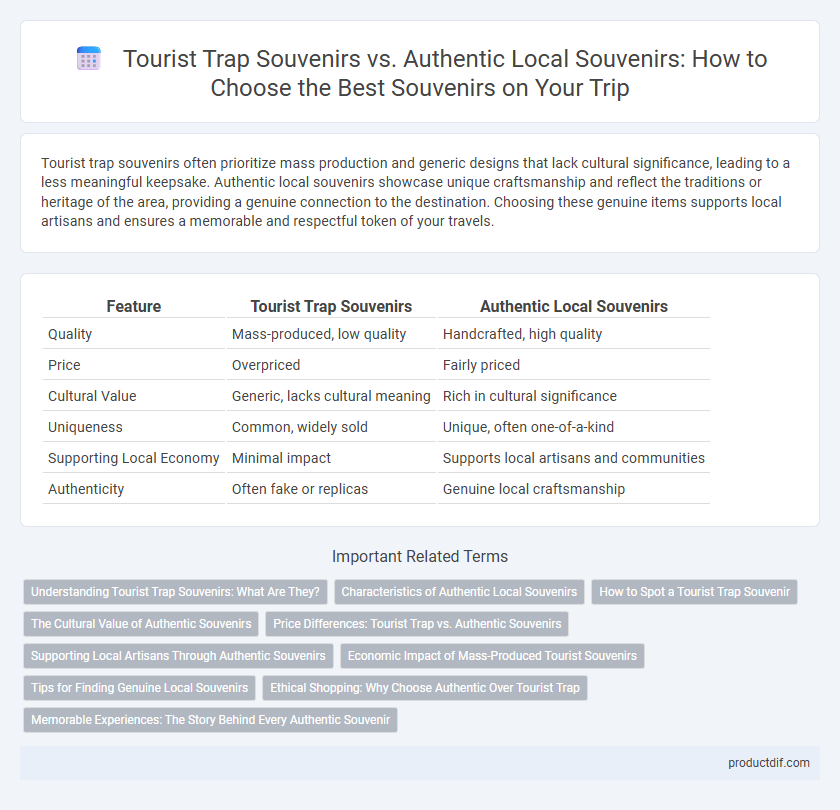Tourist trap souvenirs often prioritize mass production and generic designs that lack cultural significance, leading to a less meaningful keepsake. Authentic local souvenirs showcase unique craftsmanship and reflect the traditions or heritage of the area, providing a genuine connection to the destination. Choosing these genuine items supports local artisans and ensures a memorable and respectful token of your travels.
Table of Comparison
| Feature | Tourist Trap Souvenirs | Authentic Local Souvenirs |
|---|---|---|
| Quality | Mass-produced, low quality | Handcrafted, high quality |
| Price | Overpriced | Fairly priced |
| Cultural Value | Generic, lacks cultural meaning | Rich in cultural significance |
| Uniqueness | Common, widely sold | Unique, often one-of-a-kind |
| Supporting Local Economy | Minimal impact | Supports local artisans and communities |
| Authenticity | Often fake or replicas | Genuine local craftsmanship |
Understanding Tourist Trap Souvenirs: What Are They?
Tourist trap souvenirs often consist of mass-produced items lacking cultural significance, designed primarily to appeal to visitors seeking quick, affordable mementos. These souvenirs typically feature generic symbols or cliches associated with the destination, offering little insight into the local heritage or craftsmanship. Recognizing tourist trap souvenirs involves identifying items that prioritize quantity and convenience over authenticity and meaningful connection to the local culture.
Characteristics of Authentic Local Souvenirs
Authentic local souvenirs often showcase handcrafted artistry, incorporating traditional techniques and materials unique to the region, which reflect cultural heritage and local identity. These souvenirs typically have a story or significance tied to the community, making them meaningful keepsakes rather than mass-produced items. Genuine local souvenirs support small artisans and promote sustainable tourism by preserving regional craftsmanship and economies.
How to Spot a Tourist Trap Souvenir
Tourist trap souvenirs often feature generic designs, low-quality materials, and are sold at inflated prices in high-traffic tourist areas. Authentic local souvenirs usually showcase unique craftsmanship, cultural significance, and are available in smaller, locally-owned shops. To spot a tourist trap souvenir, look for mass-produced items lacking originality, excessive branding aimed at tourists, and vendors pushing for quick sales.
The Cultural Value of Authentic Souvenirs
Authentic local souvenirs embody the cultural heritage and traditions of a destination, offering meaningful connections to its history and artisanship. Unlike tourist trap souvenirs, which often lack originality and are mass-produced for profit, genuine souvenirs reflect the unique identity and craftsmanship of the local community. These items not only preserve cultural narratives but also support sustainable tourism by benefiting local economies and promoting cultural appreciation.
Price Differences: Tourist Trap vs. Authentic Souvenirs
Tourist trap souvenirs often come with inflated prices due to their prime locations and mass-produced nature, typically costing 30-70% more than authentic local souvenirs. Authentic souvenirs, sourced directly from local artisans or markets, offer better value and reflect genuine cultural heritage without the added markup. Consumers seeking meaningful keepsakes should prioritize authenticity to avoid paying premiums for generic, overpriced items.
Supporting Local Artisans Through Authentic Souvenirs
Authentic local souvenirs directly support local artisans by preserving traditional crafts and promoting cultural heritage, offering unique and meaningful mementos. Tourist trap souvenirs often prioritize mass production and commercial appeal, which can undermine local economies and diminish the value of genuine craftsmanship. Choosing authentic souvenirs ensures economic benefits stay in the community, empowering artisans and fostering sustainable tourism.
Economic Impact of Mass-Produced Tourist Souvenirs
Mass-produced tourist souvenirs often flood local markets, diverting revenue away from authentic artisans and small businesses, which diminishes the economic vitality of local communities. The proliferation of inexpensive, factory-made items contributes to a decline in demand for culturally significant crafts, undermining traditional economies and heritage preservation. Local economies experience reduced income generation and job opportunities as mass-produced souvenirs dominate tourist spending patterns.
Tips for Finding Genuine Local Souvenirs
Seek out souvenirs crafted by local artisans or purchased directly from markets known for handmade goods, as these items often reflect genuine cultural heritage and traditional techniques. Avoid mass-produced products sold exclusively in tourist-heavy areas, which tend to lack authenticity and cultural significance. Research locally favored shops and ask residents for recommendations to ensure the souvenirs you buy truly represent the destination's unique identity.
Ethical Shopping: Why Choose Authentic Over Tourist Trap
Choosing authentic local souvenirs supports ethical shopping by empowering local artisans and preserving cultural heritage. Tourist trap souvenirs often exploit mass production and contribute minimally to the local economy, leading to cultural dilution. Authentic items provide meaningful connections to the destination while promoting sustainable and responsible tourism practices.
Memorable Experiences: The Story Behind Every Authentic Souvenir
Authentic local souvenirs capture the essence of a destination through handmade craftsmanship and cultural significance, offering a tangible connection to memorable experiences. Unlike mass-produced tourist trap souvenirs, authentic items often come with stories that reflect local traditions and personal interactions with residents. These unique keepsakes enrich travel memories by embodying the journey's true spirit and cultural heritage.
Tourist trap souvenirs vs authentic local souvenirs Infographic

 productdif.com
productdif.com